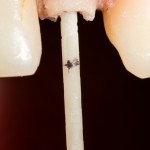
The aim of this study was to assess whether the amount of residual coronal structure and the type of cement used for fibre post luting (self-adhesive cement vs. composite core material) affected the four-year survival of root-filled premolars.
Patients requiring endodontic treatment and single-unit crown restoration of premolars were eligible. Patients were divided into two groups based on residual dentine available; Group 1- more than 50% of residual coronal structure and at least 2 sound walls; and Group 2- equal to or less than 50% of residual coronal structure, at least 1 sound wall, and a 1.5-mm ferrule effect. Patients within each group were randomised to receive either fiber posts cemented with a dual-cured composite for core build-up and post luting or fiber posts luted with a dual-cured self-adhesive universal resin cement. Success was assessed based on clinical and intra-oral radiographic examinations at the follow-up after 6, 12, 24, 36, and 48 months. Evaluation was performed independently by two blinded examiners.
- 120 patients (120 teeth) were randomised. There was no loss to follow up.
- Teeth with more than 50% of coronal structure and posts luted with core material had the highest 48-month success (90.0%) and survival rates (100%).
- Conversely, the least satisfactory clinical performance was recorded for fibre posts luted with self-adhesive cement on abutments with equal to or less than 50% of coronal residual structure (success rate 63.3%, survival rate 86.6%).
- Clinical failure was mainly due to periapical lesions and post debonding, while root fractures were observed after 3 and 4 years of clinical service.
The authors concluded
The results of the present study implied that, over a four-year observation period, the risk of failure of endodontically treated and fibre-post- restored teeth increased with a lower amount of residual coronal structure. However, the clinical performance was not affected by the material used for luting posts, and similar results were achieved with self-adhesive resin cement and resin core material.
Comment
The 2007 Cochrane review by Bolla et al which looked at the effectiveness of different post and core systems for the restoration of endodontically-treated teeth could only identify 2 randomised controlled trials which addressed the question. That review also called for more research to indicate which system should be used for different clinical cases so this new trial is welcome. However although there was no loss to follow up it is relatively small and may not have been sufficiently powered to show a different between the various system used.
Links
Juloski J, Fadda GM, Monticelli F, Fajó-Pascual M, Goracci C, Ferrari M. Four-year Survival of Endodontically Treated Premolars Restored with Fiber Posts. J Dent Res. 2014 Mar 19. [Epub ahead of print] PubMed PMID: 24646637.
Bolla M, Muller-Bolla M, Borg C, Lupi-Pegurier L, Laplanche O, Leforestier E. Root canal posts for the restoration of root filled teeth. Cochrane Database of Systematic Reviews 2007, Issue 1. Art. No.: CD004623. DOI: 10.1002/14651858.CD004623.pub2.
Dental Elf 28th Feb 2014 – Trail suggests similar outcomes with cast and glass fibre posts
